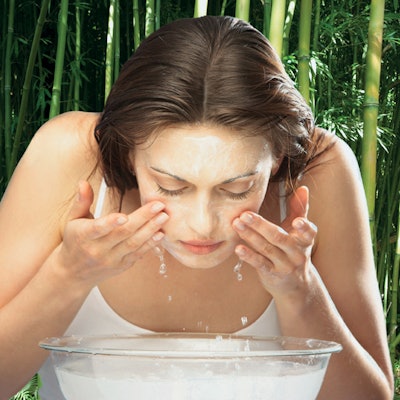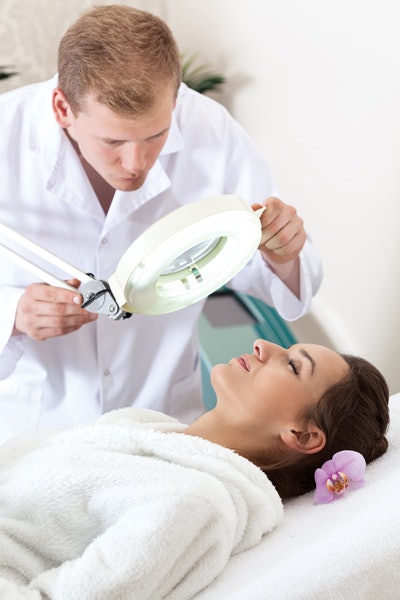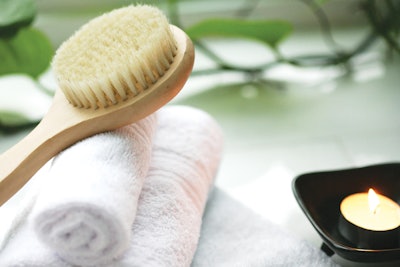 [Images: Getty Images]
[Images: Getty Images]The Basics
It’s best to cleanse twice a day. People with very dry skin or rosacea (redness and sensitivity) may be able to skip their morning cleanse, as long as they aren’t very oily.
RELATED: Spa Pros Reveal the Benefits of Retinol
When it comes to technique, they should use a circular motion following the direction of lymph flow in the face, which is up and outward toward the ears. Remind them never to wash their face with anything not specifically intended for that use, such as shampoo or shower gel.

For oily skin types, foaming cleansers are a good bet as they contain detergents that help strip away excess oil. These guests often have bigger pores that are more likely to become congested with oil and dirt, in which case salicylic acid is well-tolerated and effective ingredient for unclogging pores.
After cleansing, even oily skin may feel dry for up to 45 minutes, which is about how long it takes the oil glands to produce enough sebum to cover the skin with a moisturizing occlusive layer. So remind your patrons to wait at least that long in order to assess whether their skin needs a moisturizer– even if their skin seems dry or tight. If they moisturize right away, they run the risk of their oil glands ramping up again.
Dry Skin
Clients with dry skin should use nonfoaming cleansers, and avoid detergents and foaming agents, which can strip away the small amount of natural lipids in the skin and injure the barrier. If these guests have rosacea, acne or sensitive skin, they should also stay away from scrubs, loofahs and mechanical exfoliation. If they complain of a lack of radiance or dullness—and don’t have sensitive skin—then using a mild scrub will make a big difference. All dry skin types are best suited to milk or oil-based cleansers, or if the skin is extremely dry, a rich cream cleanser or cleansing oil.
Sensitive Skin
In my Baumann Skin Types classification system, I’ve categorized four main subtypes of sensitive skin—acne, rosacea, stinging and allergic—all of which lend themselves to a slightly different cleansing routine. However, each of these concerns requires a cleanser that will help reduce inflammation.
RELATED: Why Shea Butter is an Esthetician’s Best Friend
Acne: Benzoyl peroxide or salicylic acid cleansers are generally recommended for acne-prone skin. The former kills acne-causing bacteria, while the latter is lipophilic and able to penetrate and clear out the oil in the follicle.
The first step in choosing a cleanser for these clients is determining if their skin is oily or dry. Oilier skin does better with salicylic acid (which can be drying), whereas dry type respond better to an alpha hydroxy acid cleanser like glycolic acid. Glycolic acid is hydrophilic, so it’s water-soluble and therefore doesn’t affect the skin’s natural oil; it lowers the skin’s pH, which helps kill bacteria and exfoliate.
People with dry-skin often can’t tolerate benzoyl peroxide, but combining the ingredient with a moisturizer may help. In fact, acne-fighting cleansers can be irritating in general, so you can help clients mitigate this by inorporating moisturizers with soothing ingredients such as aloe, chamomile or green tea.
Rosacea: This skin condition can be particularly challenging to manage: In some cases, even washing with water can inflame the skin. But there are some specific cleansing tips that can help keep redness, flushing and other common flare-ups at bay. Anyone struggling with rosacea should avoid using scrubs and other friction-causing products or ingredients, as well as very hot or very cold water; instead, use only tepid water and gentle cleansing motions.
RELATED: Treating and Understanding Cellulite
These clients should seek out cleansers and moisturizers that contain anti-inflammatory ingredients like argan oil, niacinamide, resveratrol, feverfew, licorice extract, green tea and oatmeal. Ingredients with a low pH, such as glycolic acid and vitamin C, may cause stinging. If their rosacea flares during cleansing and their skin is generally not oily, advise the guest to cleanse only at night.
Stinging: When washing sensitive skin that burns or stings, clients must avoid products containing alcohol, witch hazel, vitamin C, benzoic acid, and other acids like lactic and glycolic, which can cause irritation. (People with rosacea often also suffer from skin stinging.)
Allergic: Contact dermatitis is characterized by a sudden skin rash or other adverse skin reaction caused by exposure to an allergen or irritant. Dry skin types are more likely to have allergic reactions to skincare ingredients. When dealing with contact dermatitis, first try to identify the rash’s cause. You may need to refer the client to a dermatologist who can perform a patch test and determine the exact culprit. (Most reactions to skin care are caused by products’ fragrances or preservatives.) The treatment is simple: Avoid the ingredient.

There are two types of exfoliating cleansers: mechanical and chemical. Chemical exfoliators use low pH acids to dissolve the proteins that bind
cells together; on the other hand, mechanical exfoliators use force to break these protein bonds, which can damage other proteins, lipids and membrane structures, therefore causing inflammation.
Exfoliating cleansers will strip dead cells and debris from the skin’s top layer and increase the ingredient penetration of subsequent serums and creams. Unfortunately, today’s clients may be tempted to overdo it. Be on the lookout for the sandpaper-type rash that indicates over-exfoliation, and tell those guests to discontinue their current skin-sloughing regimen. Advise them to choose only one of the items below, rather than two or three:
• A retinoid or retinol product
• A facial brush
• A cleansing scrub
• A product containing glycolic or salicylic acid
• An at-home peel
• Microdermabrasion, whether at home or professional • A facial sponge, such as Buf-Puf
Remember that clients with very dry and/or sensitive skin should approach exfoliating cleansers with caution, as these products can impair the skin barrier and stimulate inflammatory pathways, potentially leading to dehydration and inflammation. Guests should never reuse a loofah, as that type of product is a haven for acne-causing bacteria; facial brushes can also harbor bacteria, but removing the end of the brush and sanitizing it may help reduce potential breakouts.
Clients with acne should keep in mind that rough friction from a scrub or a facial brush can disrupt the keratinization process and lead to clogged pores, effectively worsening their condition. In fact, people with sensitive skin should avoid manual exfoliation altogether, as it can activate an inflammatory pathway that leads to redness, stinging and pain.
– by Leslie Baumann, MD











